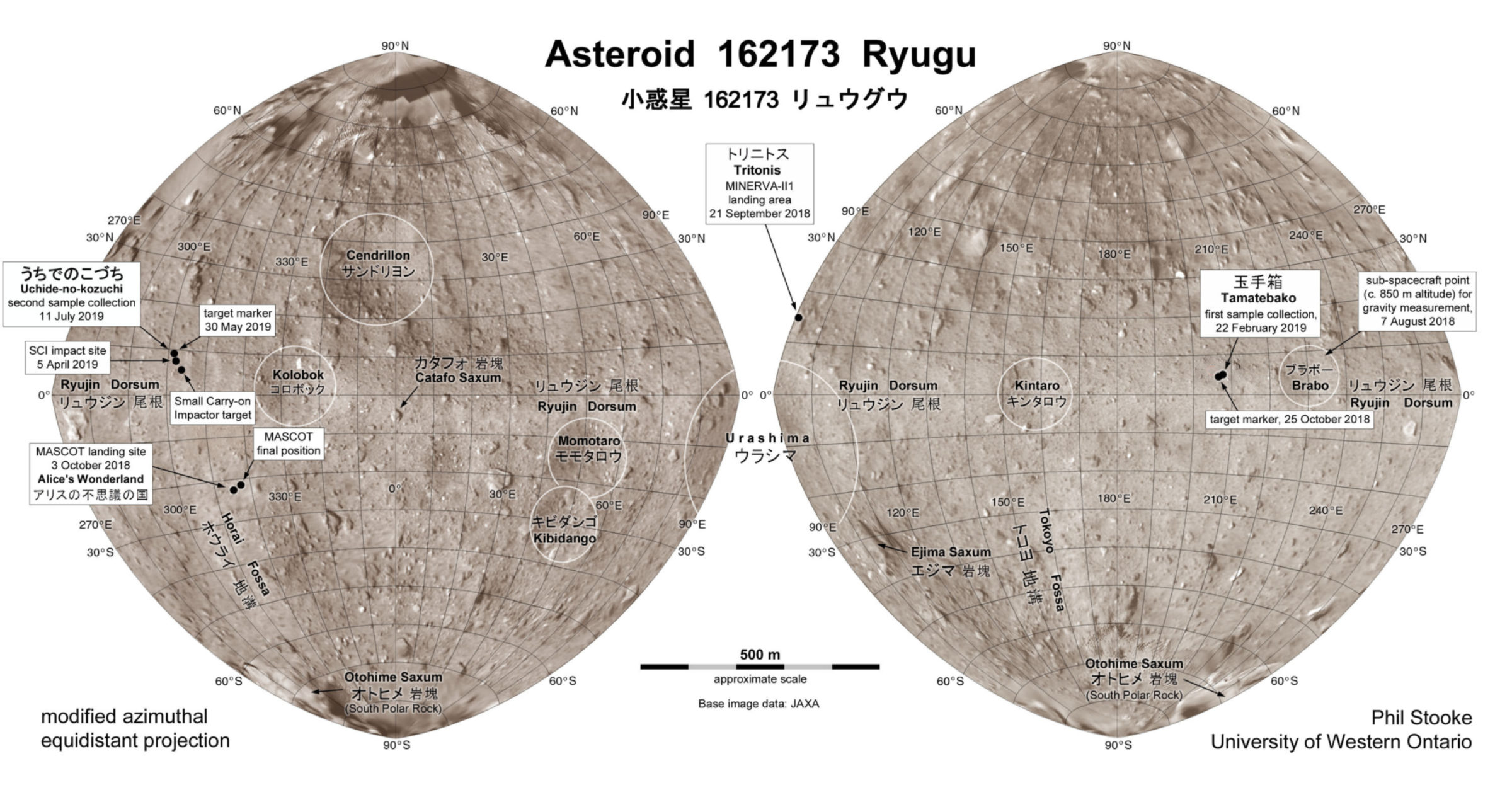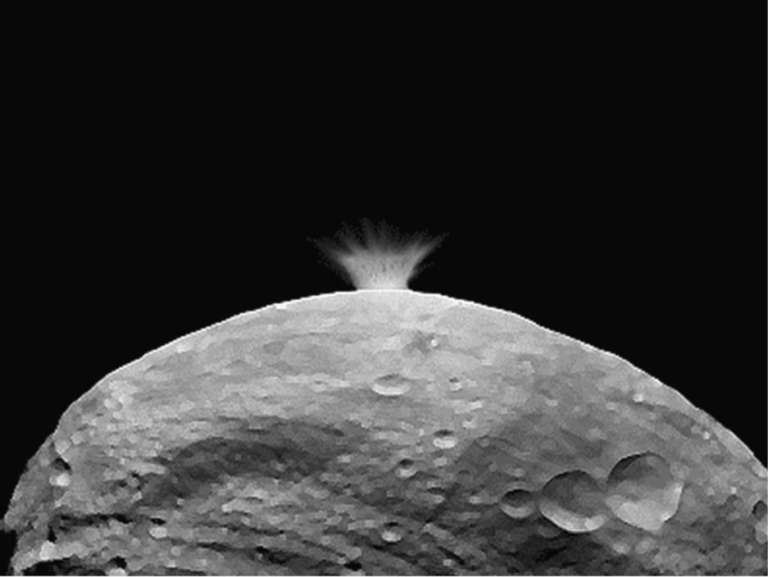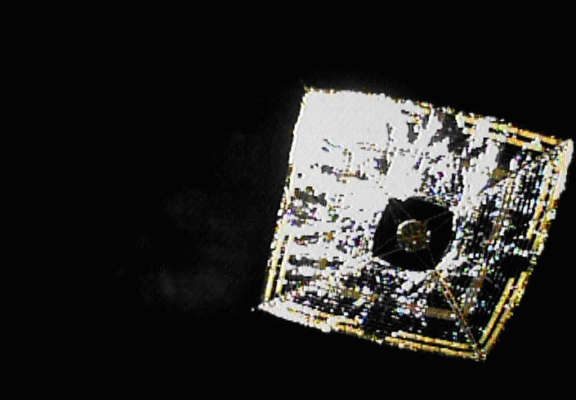Jason Davis • Apr 01, 2019
What to Expect When Hayabusa2 Blows a Hole in Asteroid Ryugu
If you enjoyed the drama of Hayabusa2's sample collection touchdown, get ready for an even bigger fireworks display. The spacecraft is about to deploy an explosives-filled box that will detonate in space, fire a copper plate into Ryugu, and create a crater up to 10 meters wide. The moment of crater generation is set for 5 April at 02:36 UTC. Here's what to expect.

Hayabusa2, Japan's mission to Ryugu and other asteroids
Hayabusa2 traveled to the asteroid Ryugu, deployed rovers on its surface, and brought samples back to Earth.
Why is JAXA doing this?
The goal of the Small Carry-on Impactor experiment—SCI for short—is to learn more about how asteroids like Ryugu change over time. More specifically, JAXA scientists are hoping to learn:
- How big a crater will form on Ryugu from an impactor of known mass and speed, by comparing before and after pictures at the crater site
- What the materials beneath Ryugu's surface that haven't been exposed to space weathering look like
- Whether or not the surface moves easily when struck by an impactor
- How easily boulders shatter due to impacts, if the impactor happens to hit a boulder
There's a lot of uncertainty involved with SCI, which makes it a really interesting experiment. Scientists aren't quite sure how big the crater will be. They can only aim SCI to a certain degree; the target spot has a margin of error of 200 meters. The width of the crater will depend on the type of material the impactor hits. Most models estimate a crater up to 10 meters wide, but there are a few surface types that could result in either a very small crater (if the impactor hits a particularly porous spot) or a crater even larger than 10 meters (if it hits a bunch of tiny, coarse pebbles). The crater depth is expected to be about a tenth of its diameter, which is actually a rule of thumb for simple, bowl-shaped craters anywhere in the solar system!
The target area is near Ryugu's equator, about a quarter of the way around the asteroid east of the first sample collection site. That’s roughly 300 meters from MASCOT’s final resting place, so it’s not impossible that SCI could hit quite close to the now-dead lander. Since the Hayabusa2 team might also collect a sample from this artificial crater, they chose a spot geologically similar to the first touchdown site, allowing for an above-and-beneath-the-surface comparison. The location is also relatively free of hazards, which should help for a future touchdown.

Here’s an image of Ryugu with the SCI target spot just a bit left of center:

How are they making the crater?
Rather than drop a bomb directly on Ryugu's surface and heavily contaminate the area with plastic explosives, the plan is to lessen contamination by turning a bomb into a space gun that fires a copper plate into the surface. You wouldn't expect to find copper on Ryugu, so this will help scientists distinguish between native and non-native Ryugu materials later. This is also the reason the sample collection process involves a bullet made of tantalum.
The SCI experiment is a small cylinder 30 centimeters in diameter and about 22 centimeters long. It sticks out from the bottom of Hayabusa2, near the meter-long sample horn:
Here's SCI before integration. SCI itself is on the right; the left piece is a cover with a white, reflective wrap that makes it easier for SCI to be imaged from a distance after deployment. The gold cap is standard spacecraft insulation that the copper projectile will blow right through.

Inside the SCI cylinder is a funnel filled with plastic explosives, capped on the wide end with a 2-kilogram curved copper plate. Delightfully, in both an academic paper and JAXA press materials, this funnel is simply referred to as the "explosive part."

Hayabusa2 will deploy SCI from a height of 500 meters and start a 40-minute timer before detonation. The cylinder has no means of attitude control, so Hayabusa2 will give it a slight spin to stabilize it as it gently falls toward Ryugu.
And then, Hayabusa2 will run. It will first make a "horizontal retreat," sliding sideways for about a kilometer. Then, it will drop off a camera system called DCAM3 to watch the fireworks (more on that in a moment) before making a "vertical retreat" until it is safely shielded from the SCI explosion by Ryugu.

Here are the key SCI event times. All are in Earth-received time; to calculate the time the event occurred aboard the spacecraft, subtract 17 minutes.
| Event | PDT | EDT | UTC | Japan |
|---|---|---|---|---|
| SCI deployment | 19:13 4 April | 22:13 4 April | 02:13 5 April | 11:13 5 April |
| DCAM3 deployment | 19:31 4 April | 22:31 4 April | 02:31 5 April | 11:31 5 April |
| SCI detonation and crater formation | 19:53 4 April | 22:53 4 April | 02:53 5 April | 11:53 5 April |
JAXA hasn't listed an exact height at which SCI will detonate. Full-scale tests on Earth were conducted at 100 meters, and a 2017 paper said the cylinder would fall to at least 200 meters while Hayabusa2 escaped, so it's safe to say somewhere between 100 and 200 meters. When detonation occurs, it will take just milliseconds for the "explosive part" to accelerate the copper plate to a speed of about 2 kilometers per second, much faster than the sample collection bullet that travels at 300 meters per second. The curved copper plate will actually turn inside out and become helmet-shaped before it slams into Ryugu.

If all goes well, Hayabusa2 will stay in direct line-of-sight with DCAM3 while being shielded from high-speed SCI debris and crater ejecta.
What will we see?
Before answering what we'll see from SCI, let's look at what we won't see. Here's a video made from 2011 full-scale tests of SCI on Earth. WARNING: IT'S VERY LOUD. I jumped the first time I watched the test, but was so awestruck I left the audio levels intact, and used the track from the microphone closest to the experiment for both camera angles.
Hayabusa2 SCI tests WARNING: LOUD. This video shows two camera angles from a test of Hayabusa2's SCI experiment on Earth in 2011. The copper projectile fires from a concrete bunker, penetrates several gridded targets, and hits a mound of dirt simulating asteroid Ryugu 100 meters away.Video: JAXA / Jason Davis / The Planetary Society
It would be incredible to see that video recreated in microgravity, but sadly, DCAM3 will be a kilometer away. Here's an approximation of what we might actually see:

That's still pretty cool! DCAM3, or Deployable Camera 3, is an evolution of the DCAM1 and DCAM2 systems that were used during JAXA's IKAROS mission in 2010. IKAROS, you might recall, was the world's first steerable solar sail that hitched a ride to interplanetary space on the rocket that sent Akatsuki to Venus.

DCAM3 has two cameras: one low-resolution color analog camera that will transmit to Hayabusa2 in real-time, and a higher-resolution monochrome digital camera that will send images later. DCAM3's battery will only last 3 hours, but its signal is strong enough to reach Hayabusa2 10 kilometers away. There's also a camera called MCAM that will image DCAM3 as it pops loose from Hayabusa2.
What's next?
To avoid any slow-speed crater ejecta that briefly enters orbit around Ryugu before either falling back to the surface or getting pushed into space due to solar radiation pressure, Hayabusa2 will wait 2 weeks before returning to its 20-kilometer home position. Eventually, the spacecraft will return to the scene of the crime to see what happened. The team already collected pre-SCI imagery of the crater formation area from a height of about 1.7 kilometers. These images will help the team locate the new, artificial crater.
Then, they will decide whether to perform a second touchdown, either in the artificial crater they just created, or at a nearby location called S01, which they observed in detail from 6 to 8 March at a height of 22 meters. A second touchdown wouldn't happen until June at the earliest.
One final note: The mission has updated their spacecraft renderings based on what they now know about Ryugu (don't miss Emily's new article that discusses this in detail!). Here are before-and-after shots of Hayabusa2 touching down. The surface certainly turned out to be a lot rockier than expected!
Support our core enterprises
Your support powers our mission to explore worlds, find life, and defend Earth. You make all the difference when you make a gift. Give today!
Donate

 Explore Worlds
Explore Worlds Find Life
Find Life Defend Earth
Defend Earth





